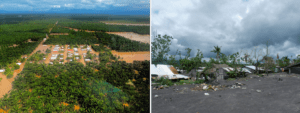
Engineering for Everyone: How Tech Tools are Democratizing Disaster-Resilient Housing

Monica Schroeder
VP of Global Engagement
The demand for robust, affordable, and accessible housing solutions is universal. But, while the technical knowledge to build safer structures exists, it has historically been out of reach for many of the very communities that need it most. By putting powerful technical tools directly into the hands of those who need them, technology is not just mitigating risk; it’s actively building stronger, safer, and more resilient communities for generations to come.
The Growing Imperative for Resilient Homes
Extreme weather events are becoming the norm, displacing millions and causing billions in damages each year. Beyond the immediate destruction, these events exacerbate existing housing crises, driving up costs and disproportionately affecting vulnerable populations. Low-income communities, often situated in high-risk areas due to historical inequities, face a steeper climb to recovery, with many unable to rebuild or secure affordable and safe housing.
This reality underscores a critical need: how can we empower everyone, regardless of their technical background, location, or access to resources to participate in building a more secure future? One key component lies in democratizing access to the tools and knowledge traditionally reserved for specialists: through development of applications that are made with and for these communities, we can scale efficiency for permanent solutions tailor-made for underserved communities.
Bridging the Gap: Accessible Engineering Through Technology
BCtap, Build Change’s technical assistance platform, has been developed to meet specifically these challenges. As both a web-based and offline-first mobile tool that serves to digitalize all aspects of the six-step construction value chain.

Through a human-centered design approach, BCtap provides hands-on training and technical assistance to local builders, homeowners, and engineers and architects, ensuring that homes are built or retrofitted to better cope with earthquakes, extreme weather, and other hazards. It is a scalable, cost-effective solution that addresses the root causes, improving safety, economic stability, and quality of life for vulnerable communities worldwide.
Specifically, we have focused on the development of a few key aspects to improve accessibility for a greater number of stakeholders in the construction value chain:
- Multi-user designs: BCtap is used not only by engineers and architects, but designed to be used by program administrators, microfinance loan officers, and homeowners. In this way, BCtap facilitates financing access, most frequently through microfinance institutions and/or government subsidies, to provide affordable loans tailored to housing needs. This financing enables families to build or retrofit homes that improve their disaster resilience. This approach not only bridges a significant knowledge gap but also fosters local ownership and self-sufficiency, ensuring that vulnerable communities can proactively build safer futures rather than being solely reliant on external, often delayed, aid.
- Offline-first capabilities: In many areas where Build Change supports housing systems, internet infrastructure is often unreliable, expensive, or simply non-existent in remote areas, an offline-first mobile application is not merely a convenience, but a critical necessity. For communities grappling with limited bandwidth and intermittent connectivity, relying on constant internet access for essential services and tools is a barrier to progress. An offline-first approach ensures that critical data, resources, and functionalities are always available on the device, allowing users to perform vital tasks like collecting field data, even without a signal. This mobile architecture not only enhances user experience by eliminating interruptions, but also empowers individuals in underserved communities to participate fully in initiatives that can improve their lives.
- Customizable features: Although created within a normalized platform, BCtap can be customized to fit the needs of the program. A one-size-fits-all approach isn’t possible for designing disaster-resilient housing across varied geographic locations, cultural contexts, and local building material availability. Customizable features allow users to adapt the tool to their specific environment, whether it’s adjusting for a specific design or selecting materials readily available in their region. This flexibility fosters greater adoption and relevance, enabling communities to build truly appropriate and sustainable solutions, rather than being constrained by rigid templates. By empowering users to tailor the platform to their precise requirements, BCtap can become a tool for context-specific resilience, moving beyond generic recommendations to offer truly impactful and practical guidance.
Building a Resilient Future, One Accessible Solution at a Time

The challenges of a changing climate and the persistent demand for safe, affordable housing underscore a clear imperative: we must empower every community to build resiliently. The era of complex, exclusive engineering is giving way to a more inclusive future, driven by accessible technology. Platforms like BCtap are at the forefront of this transformation, proving that sophisticated solutions can be delivered to non-technical users, even in the most resource-constrained environments. By focusing on multi-user designs that integrate critical financial access, prioritizing offline-first capabilities for ubiquitous reach, and ensuring customizable features for context-specific relevance, we are not just building houses; we are building stronger, more self-reliant communities.
This human-centered technological shift inherently drives significant efficiencies, not only within start-up processes for housing programs but also across actors in the broader construction value chain. By digitalizing and streamlining the design, financing, and implementation phases, manual bottlenecks are eliminated, communication is enhanced, and resources are optimized. This translates to faster project completion, reduced costs, and a more effective allocation of labor and materials, ensuring that more families can move into safer homes, quicker.
Incorporating Artificial Intelligence (AI)
Looking ahead, the strategic adoption of an AI-ready approach is crucial, a process that Build Change has started through the development of a multilingual chatbot trained on disaster risk data, resilient engineering methods, available materials, and localized construction resources. This AI tool, which is being piloted in our Philippines program with the goal of scaling to other locations, will help these stakeholders groups execute actionable home improvements that will protect lives and livelihoods with resilient housing.
By designing platforms with data collection and integration in mind from the outset, we lay the groundwork for leveraging artificial intelligence. AI can revolutionize areas like predictive analytics for material needs, generative design for optimal structural solutions, automated quality control, and even risk assessment, making the entire process even smarter, more efficient, and ultimately, more resilient to the challenges of tomorrow.
Support resilient housing worldwide
Join us in preventing housing loss caused by disasters.
Donate nowNewsletter
Sign up for our newsletter to receive updates on our latest news, events, and more.
